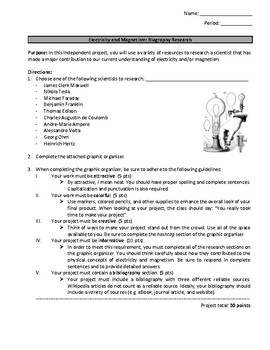Electricity and Magnetism: Biography Research
Miss Franzi's Science Tools
12 Followers
Grade Levels
7th - 12th, Homeschool
Subjects
Resource Type
Standards
NGSSHS-PS2-5
NGSSMS-PS2-3
NGSSHS-PS2-6
NGSSMS-PS2-5
Formats Included
- PDF
Pages
2 pages
Miss Franzi's Science Tools
12 Followers
Description
In this independent learning project, students use a variety of credible sources to research a scientist that has made a major contribution to our current understanding of electricity and/or magnetism.
Instructions are super straightforward - makes for fantastic SUB PLANS.
Total Pages
2 pages
Answer Key
Not Included
Teaching Duration
1 hour
Report this resource to TPT
Reported resources will be reviewed by our team. Report this resource to let us know if this resource violates TPT’s content guidelines.
Standards
to see state-specific standards (only available in the US).
NGSSHS-PS2-5
Plan and conduct an investigation to provide evidence that an electric current can produce a magnetic field and that a changing magnetic field can produce an electric current. Assessment is limited to designing and conducting investigations with provided materials and tools.
NGSSMS-PS2-3
Ask questions about data to determine the factors that affect the strength of electric and magnetic forces. Examples of devices that use electric and magnetic forces could include electromagnets, electric motors, or generators. Examples of data could include the effect of the number of turns of wire on the strength of an electromagnet, or the effect of increasing the number or strength of magnets on the speed of an electric motor. Assessment about questions that require quantitative answers is limited to proportional reasoning and algebraic thinking.
NGSSHS-PS2-6
Communicate scientific and technical information about why the molecular-level structure is important in the functioning of designed materials. Emphasis is on the attractive and repulsive forces that determine the functioning of the material. Examples could include why electrically conductive materials are often made of metal, flexible but durable materials are made up of long chained molecules, and pharmaceuticals are designed to interact with specific receptors. Assessment is limited to provided molecular structures of specific designed materials.
NGSSMS-PS2-5
Conduct an investigation and evaluate the experimental design to provide evidence that fields exist between objects exerting forces on each other even though the objects are not in contact. Examples of this phenomenon could include the interactions of magnets, electrically-charged strips of tape, and electrically-charged pith balls. Examples of investigations could include first-hand experiences or simulations. Assessment is limited to electric and magnetic fields, and limited to qualitative evidence for the existence of fields.



